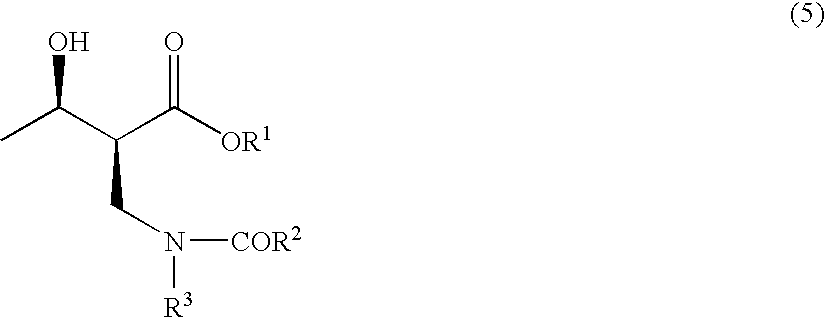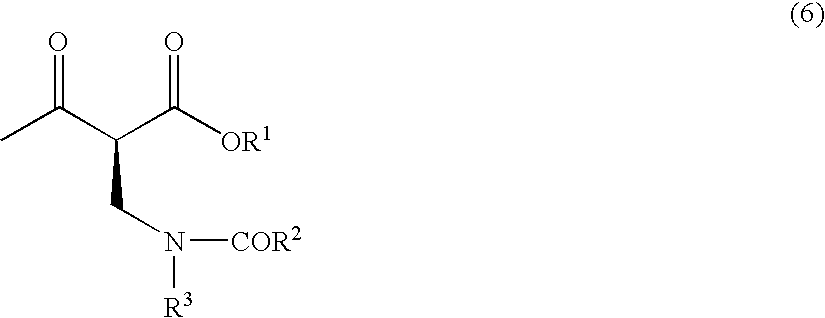Method for producing optically active 2-(n-substituted aminomethyl)-3-hydroxybutyric acid ester
a technology of aminomethyl and ester, which is applied in the direction of fertilization, etc., can solve the problems of unsatisfactory method from the commercial production and economic viewpoin
- Summary
- Abstract
- Description
- Claims
- Application Information
AI Technical Summary
Benefits of technology
Problems solved by technology
Method used
Image
Examples
example 1
Reactions Using Microorganisms Shown in Table 1
[0051]A liquid medium (pH 7) having a composition comprising 40 g of glucose, 3 g of yeast extract, 6.5 g of diammonium hydrogen phosphate, 1 g of potassium dihydrogen phosphate, 0.8 g of magnesium sulfate heptahydrate, 60 mg of zinc sulfate heptahydrate, 90 mg of iron sulfate heptahydrate, 5 mg of copper sulfate pentahydrate, 10 mg of manganese sulfate tetrahydrate and 100 mg of sodium chloride (each per liter) was distributed in 5-ml portions into large-sized test tubes, and steam-sterilized at 120° C. for 20 minutes. These liquid media were respectively inoculated aseptically with the microorganisms shown in Table 1 given below (the inoculum size being one loopful), followed by 72 hours of shake culture at 30° C. After cultivation, each culture fluid was centrifuged and the thus-collected cells were suspended in 0.5 ml of 100 mM phosphate buffer (pH 6.5) containing 1% of glucose.
example 2
Reactions Using Microorganisms Shown in Table 2
[0053]A liquid medium (pH 7) having a composition comprising 10 g of meat extract, 10 g of peptone, 5 g of yeast extract and 3 g of sodium chloride (each per liter) was distributed in 7-ml portions into large-sized test tubes and steam-sterilized at 120° C. for 20 minutes. These liquid media were respectively inoculated aseptically with the microorganisms shown below in Table 2 (the inoculum size being one loopful), followed by 72 hours of shake culture at 30° C. After cultivation, each culture fluid was centrifuged and the thus-collected cells were suspended in 0.5 ml of 100 mM phosphate buffer (pH 6.5) containing 1% of glucose.
[0054]This cell suspension was added to a test tube containing 2.5 mg of methyl 2-benzamidomethyl-3-oxobutyrate placed therein in advance and the reaction was allowed to proceed at 30° C. for 24 hours. Thereafter, 1 ml of ethyl acetate was added to each reaction mixture and, after thorough mixing, a portion of t...
example 3
Reactions Using Microorganisms Shown in Table 3
[0055]A liquid medium (pH 7) having a composition comprising 10 g of glucose, 10 g of peptone, 10 g of meat extract, 5 g of yeast extract 1 g of sodium chloride and 0.5 g of magnesium sulfate heptahydrate (each per liter) was distributed in 5-ml portions into large-sized test tubes and steam-sterilized at 120° C. for 20 minutes. These liquid media were respectively inoculated aseptically with the microorganisms shown below in Table 3 (the inoculum size being one loopful), followed by 72 hours of shake culture at 28° C. After cultivation, each culture fluid was centrifuged and the thus-collected cells were suspended in 1 ml of 100 mM phosphate buffer (pH 6.5) containing 1% of glucose.
[0056]This cell suspension was added to a test tube containing 1 mg of methyl 2-benzamidomethyl-3-oxobutyrate placed therein in advance and the reaction was allowed to proceed at 30° C. for 24 hours. Thereafter, 2 ml of ethyl acetate was added to each reacti...
PUM
| Property | Measurement | Unit |
|---|---|---|
| hydrogen pressure | aaaaa | aaaaa |
| pH | aaaaa | aaaaa |
| temperature | aaaaa | aaaaa |
Abstract
Description
Claims
Application Information
 Login to View More
Login to View More - R&D
- Intellectual Property
- Life Sciences
- Materials
- Tech Scout
- Unparalleled Data Quality
- Higher Quality Content
- 60% Fewer Hallucinations
Browse by: Latest US Patents, China's latest patents, Technical Efficacy Thesaurus, Application Domain, Technology Topic, Popular Technical Reports.
© 2025 PatSnap. All rights reserved.Legal|Privacy policy|Modern Slavery Act Transparency Statement|Sitemap|About US| Contact US: help@patsnap.com



